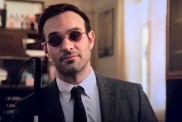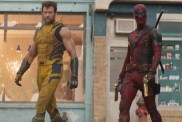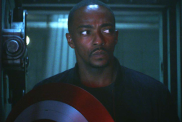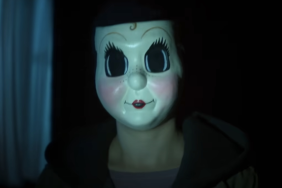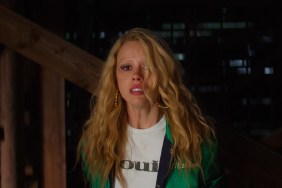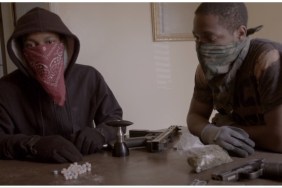Kim Bodnia as Frank
Zlatko Buric as Milo
Mads Mikkelsen as Tonny
Slavko Labovic as Radovan
Laura Drasbæk as Vic
Peter Andersson as Hasse
Vanja Bajicic as Branko
Lisbeth Rasmussen as Rita
Levino Jensen as Mike
Leif Sylvester as Smeden
Anne Sørensen as Charlotte
Øyvind Hagen-Traberg as Ø
Kurt Nielsen as Kusse-Kurt
Karsten Schrøder as Røde
Maria Erwolter as Gry
Marinela Dekic as Milena
Ilyas Agac as Little Mohammed
Gitte Dan as Lis
Dan Dommer as Gamle
Ramadan Huseini as Rexho
Directed by Nicolas Winding Refn
Summary:
Refn’s Danish gritty crime trilogy takes a realistic look at the Copenhagen drug scene in a way that keeps your attention riveted to every move of its “protagonists.”
Story:
“Pusher” follows proficient Copenhagen drug dealer Frank (Kim Bodnia) on a crazy night trying to scrape together the money to pay off his ever-increasing debt to the city’s brutal crime boss Milo (Zlatko Buric).
“Pusher II: With Blood On My Hands” follows Frank’s former partner Tonny (Mads Mikkelsen) after he gets out of jail, trying to deal with the fact that he has had a son with a former girlfriend and the fact that his father doesn’t appreciate or respect him.
“Pusher III: I’m the Angel of Death” is about Milo, who has become clean from drugs, only to get dragged back into that world with his own drug deal gone wrong, coinciding with his daughter’s 25th birthday party.
Analysis:
You really have to give credit to Danish director Nicolas Winding Refn, not only for creating an innovative form of crime drama with his 1996 debut “Pusher,” but also for following it up years later with two films of similar quality, made completely independently on his own terms.
Preceding Guy Ritchie’s “Lock, Stock and Two Smoking Barrels” by two years, “Pusher” used similar sensibilities in humanizing criminals and drug dealers, except it was done on a smaller budget, mostly in real time, with the camera staying fixed on the lead character like a cross-section of a pivotal moment in their lives. Its two sequels used a similar method to look at different characters, and in all three cases, the story revolved around the lead character getting into trouble because of a drug deal gone wrong, leading to all sorts of conflicts.
The first movie introduces Frank, a drug dealer who drives around with his partner Tonny, having conversations about women, sex and mundane topics until a drug deal goes sour, putting Frank massively into debt with drug kingpin and restaurateur Milo. The majority of the film has Frank racing around town trying to collect money from various clients in order to pay Milo the money he owes, knowing that his life hangs in the balance. “Pusher” really was cutting edge for its time, giving the viewer a fly on the wall look into the lives of drug dealers and hoods, never looking away, telling you how to feel or judging them for the things they do, however wrong they might be. Despite their criminal connection, each character has a softer side as seen through their relationship with others; in Frank’s case, it’s his platonic stripper girlfriend, Tonny has his illegitimate baby and Milo has the daughter he is trying to protect from his life of crime.
Each movie works well as a standalone, but each character’s arc gains more weight as part of the whole. The fine line between good and bad are inconsequential as Milo, the antagonist of the first movie, becomes the hero of the third, while supporting characters that only appear for a few minutes in one movie play a larger part in later stories and vice versa. Tonny’s crime partner in “Pusher II” briefly shows up for a pivotal scene in Milo’s story in “Pusher III,” while Milo’s henchman Radovan plays a big part in “Pusher,” is mysteriously absent from second chapter, only to return in the finale, where we learn that he gave up on crime but returns to help Milo out of a tough spot. To show the significant passage of time between movies, each character looks different when reintroduced.
It’s surprising to learn how fascinating it is to watch criminals going through their everyday lives and then having a monkey wrench thrown into the works, but it leads to some exciting moments among the more mundane dialogue scenes. The lack of music creates its own unique effect when it reemerges for some of the more fast-paced scenes.
The writing is natural and fluid largely due to the delivery by the talented cast Refn assembles for each tale. Kim Bodnia’s Frank is a favorite if only because his story ends up being the most exciting, finding himself in tense circumstances. Mads Mikkelsen is probably a stronger actor, but Tonny’s dim-witted demeanor in “Pusher II” and the slower nature of the story is a bit of a let-down after seeing him verbally sparring with Frank in the first movie. There’s a lot more sex and nudity in the second movie, which coincides with Tonny’s vulgar opinions of women in the first movie.
The first movie is still probably the best, if only because it moves at a brisker pace and has more violence, though the finale of “Pusher III” caps off with a graphic scene of Milo dispensing with one of his enemies in a way that will make the strongest stomachs buckle.
Overall, “The Pusher Trilogy” is an impressive achievement in serialized storytelling, removing any shades of grey that might surround the lives of criminals, by showing them as stark and realistically as possible. Each movie ends in a strange place to let us know that we’re only watching a part of these character’s lives and that their story doesn’t end there. It’s almost as if Refn wants to force the viewer to decide what happens to each character for themselves, made obvious by the absence of Frank and Tonny in the subsequent chapters. It’s a bit frustrating, but it adds to the trilogy’s mystique.
The Bottom Line:
Anyone who enjoys solid crime-drama, whether it be on TV or in movies, should appreciate Nicolas Refn’s rough and gritty trio of movies. If you’re only able to see one of them, then the first part is still the best, with the third part falling close behind. There isn’t much continuation between the three that it’s necessary to see them in any particular order, but you’ll get much more out of the trilogy as a whole if you see them in the order they were made.
The Pusher Trilogy opens today at the Cinema Village in New York, but one can expect that it will be shuttled around the country in the coming weeks.


